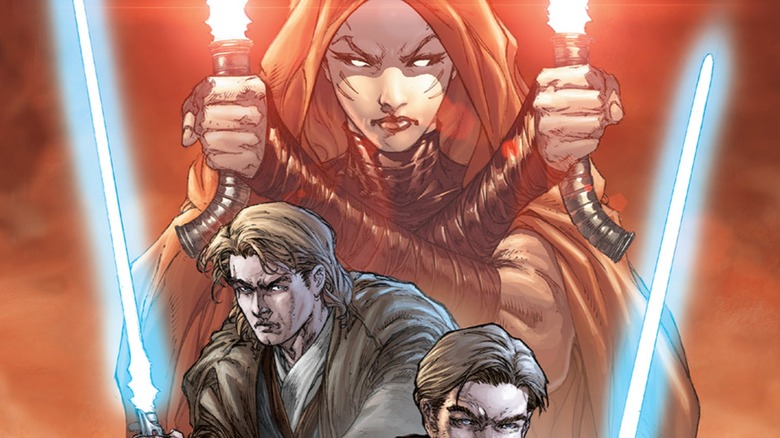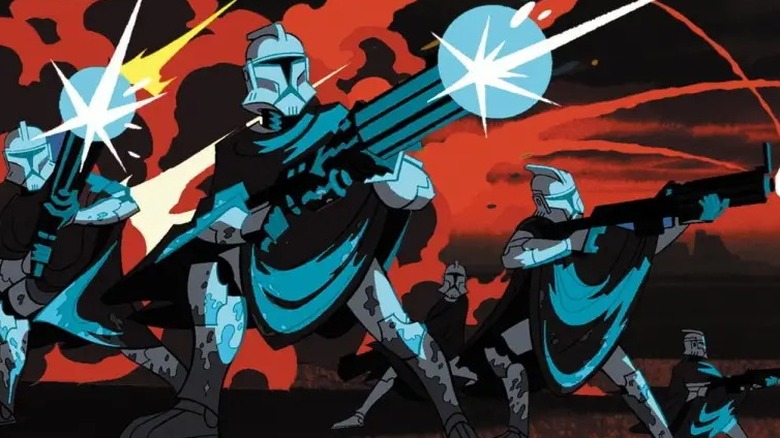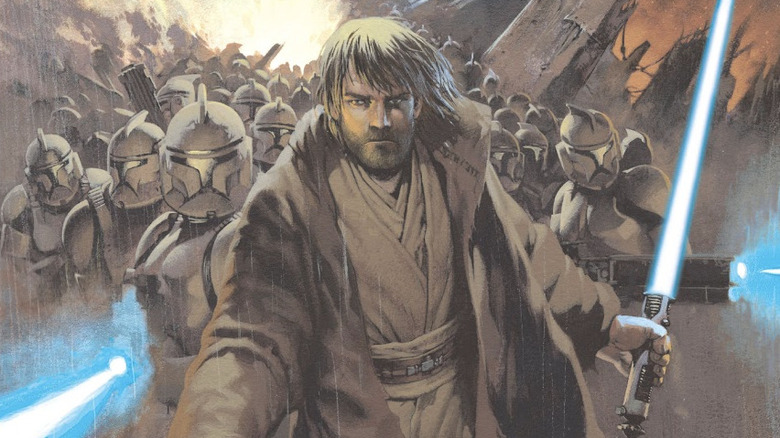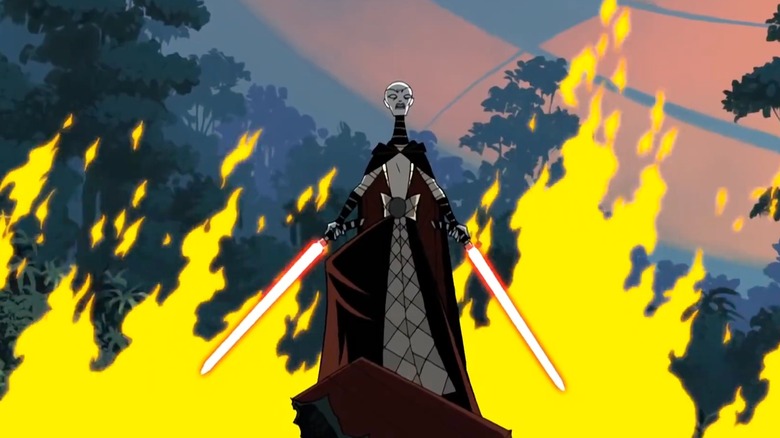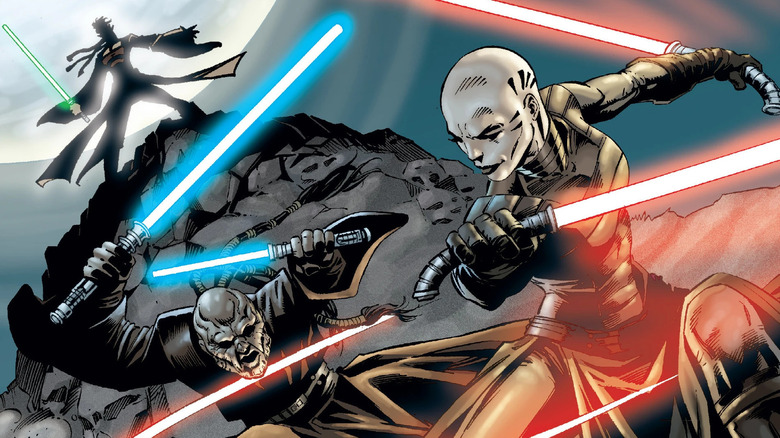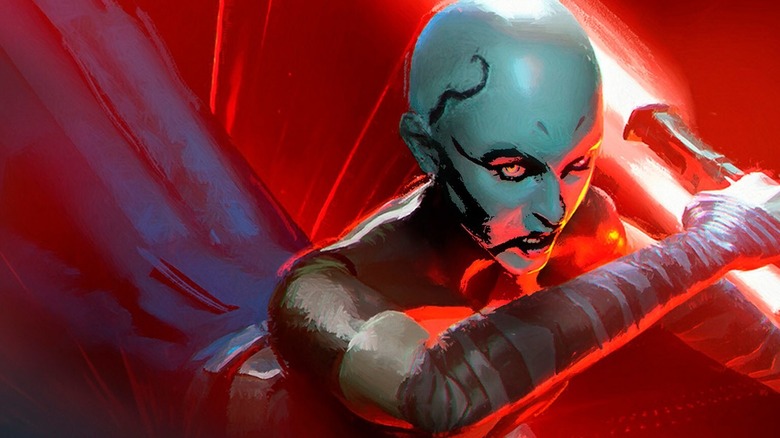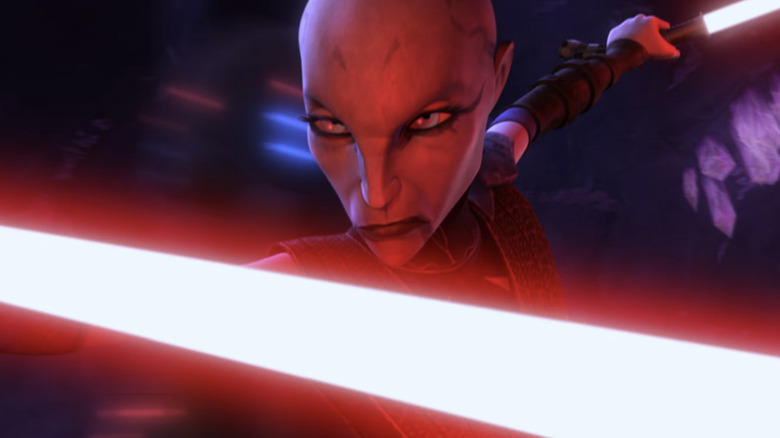Why The Clone Wars Changed Asajj Ventress' Story From The Star Wars Comics
The 2008 cartoon series "Star Wars: The Clone Wars" is now a heralded piece of the "Star Wars" legacy, filling in plenty of gaps in the "Star Wars" prequel film trilogy. It also finally told the story of the eponymous conflict — which was first namedropped all the way back in the original 1977 "Star Wars." "The Clone Wars" was a story that had been speculated on for more than 40 years. What if I told you, though, that the story had already been recounted by 2008?
In between the theatrical releases of "Attack of the Clones" (in 2002) and "Revenge of the Sith" (in 2005), Lucasfilm launched "The Clone Wars Multimedia Project." This was a collection of tie-in media telling the story between the films of a galaxy at war.
The essentials of the project include:
-
"Star Wars: Clone Wars," an animated series directed by Genndy Tartakovsky of "Samurai Jack" fame.
-
Issues #49-83 of the "Star Wars: Republic" comic series, written by John Ostrander.
-
"Shatterpoint," a novel by Matt Stover (who went on to write the novelization of "Revenge of the Sith") about Jedi Master Mace Windu.
-
"Yoda: Dark Rendezvous" by Sean Stewart. Yoda meets his former apprentice, the Sith Lord/Separatist leader Count Dooku, and attempts to negotiate an end to the war/pull Dooku back to the light.
-
"Labyrinth of Evil" by James Luceno. A prequel of sorts to "Revenge of the Sith" (one in which the Jedi nearly track down Darth Sidious), the novel overlaps (and in some ways contradicts) the final episodes of Tartakovsky's "Clone Wars."
One of the most famous additions that the multimedia project makes to "Star Wars" is Asajj Ventress, the Dark Jedi and Dooku's personal assassin. She was even incorporated into the 2008 "Clone Wars" series — but with many differences.
A Second Clone Wars
If "Star Wars" had already chronicled the Clone Wars, then why did George Lucas go back to this well and make the "Clone Wars" animated series?
Lucas announced the new series at the 2005 "Star Wars" convention, Celebration III, referring to the original Tartakovsky mini-series as a "pilot series." It should be noted that the 2003 "Clone Wars" was originally a series of action-heavy shorts (some running as briefly as three minutes long). Even the longer episodes of season 3 were only about 12-15 minutes, about half the length of a normal cartoon episode.
Lucas evidently saw the series as a proof of concept to do a Clone Wars cartoon with more in-depth storytelling. There's also the choice to use CGI animation, which still wasn't the norm in 2008. Lucas is a pioneer of film technology and a major proponent of digital media (it's what brought him back to "Star Wars" in the first place), so overseeing a cartoon series in a newish style would've awakened his filmmaking spirit. Indeed, the animation is what convinced him to be more hands-on with "The Clone Wars" than he'd first expected to be.
Clone Wars Legends
As for the storytelling? Dave Filoni, a director on "The Clone Wars," has said Lucas always saw the "Expanded Universe" as unofficial:
"Having worked with George, it was always very clear and he made it very clear that the films and TV shows are the only thing that he considered canon. That was it. So everything else was a world of fun ideas, exciting characters, great possibilities, but the EU was created to explore all those things."
Since the 2008 "Clone Wars" is the one Lucas was directly involved in, it's the one that Lucasfilm recognizes as the canonical version and what future "Star Wars" has and will continue to build off of. The novels, comics, and Tartakovsky's "Clone Wars" cartoon are now "Star Wars Legends."
There were some incongruities from the beginning. Most obviously, the presence of Anakin's apprentice Ahsoka Tano (Ashley Eckstein), who was created for "The Clone Wars." However, early on, "The Clone Wars" maintains some pretense of fitting in with the multimedia project.
Anakin ended "Attack of the Clones" as a Padawan, but when "The Clone Wars" begins, he's already a Jedi Knight. Why? It might be because his knighting ceremony was shown in the Tartakovsky "Clone Wars." Ventress and General Grievous got dramatic introductions in the original "Clone Wars" too, so the 2008 series debuts them as if the audience is already familiar with them.
It's understandable that "The Clone Wars" team didn't want to be more burdened by continuity than they already had to be (what with the films and all). Once it was clear the show was a success, they got comfortable doing their own thing. Season 3 of "The Clone Wars" is when things really go off the rails with the previous EU "canon," Ventress included.
Ventress in Star Wars Legends
Who created Asajj Ventress? That's a question without a precise answer. Her design originates with concept artist Dermot Power, who drew a pale, bald, female Sith Lord as a potential villain for "Attack of the Clones." The design went unused in the film, but Lucasfilm recycled it for Asajj. Power does not claim ownership over the character despite this ("loved Assaj but she had nothing to do with me," he tweeted in 2020). Her name came from Lucasfilm's Leland Chee, after Lady Asaji in Akira Kurosawa's "Throne of Blood."
Ventress first appeared in the 2003 comic, "Jedi: Mace Windu" written by Ostrander (though her first appearance in the 2003 "Clone Wars" comes before this chronologically). While Windu goes to negotiate with a group of disillusioned Jedi refusing to fight in the Clone Wars, Ventress is sent by Dooku to assassinate them all. It turns out that the exiles' leader, Sora Bulq, is in league with Dooku, and the whole plot was meant to discredit Windu. Here's another difference between earlier and later Clone Wars media; in the former, Dooku has several fallen Jedi serving him (such as Bulq and Jedi double agent Quinlan Vos). In the latter, it's just Ventress.
The 2003 "Clone Wars" shows how Ventress became Dooku's assassin, but it introduces her without context; she's already fallen to the dark side and her backstory isn't divulged. Ostrander revealed her origins in "Republic" issue #60: Asajj is the orphaned daughter of two warlords on the planet Rattatak. After her parents' death, she was raised by stranded Jedi Master Ky Narec — and still reveres him. After he was killed, she fell to the dark, hating the Jedi for abandoning her teacher, and rules Rattatak with an iron fist.
The legend of Ventress continues
In "Clone Wars," Ventress fights only Anakin; he defeats her and she falls down a chasm on the moon Yavin 4. In the show itself, it's obviously supposed to be a death scene for Ventress. Ostrander apparently wasn't willing to let her go, though, and she continued to appear in the "Republic" comics. These stories make Ventress more of Obi-Wan's enemy.
In issues #51-52, she fights him alongside the armored bounty hunter Durge (who Obi-Wan also fights in "Clone Wars"). After the Republic's defeat at the battle of planet Jabiim, Ventress holds a presumed-dead Kenobi and clone trooper Alpha hostage on Rattatak for three weeks, torturing them. To escape, Obi-Wan steals Narec's lightsaber, further escalating their feud.
In "Republic" #71, Ventress stows away to Coruscant and fights Anakin again, giving him his facial scars with her lightsabers. When she threatens Padmé, though, an enraged Anakin telepathically ensnares her in sparking wires and again drops her to her seeming doom.
In the five-issue mini-series "Star Wars: Obsession" (written by Haden Blackman, drawn by Brian Ching), Obi-Wan is hunting Ventress, convinced she's still alive despite evidence to the contrary. It turns out he's right; the last page of issue #4 reveals Ventress being healed in Dooku's stronghold on the planet Boz Pity.
It turns out Obi-Wan isn't searching for Ventress to kill her but because he believes he can turn her away from the dark side. She laughs in his face ... until Dooku has her shot and abandons her to the Jedi, deciding she's failed too many times. She dies in Obi-Wan's arms, or rather appears too. She fakes her death, and after Obi-Wan orders her "corpse" brought to Coruscant for a proper funeral, she hijacks the ship, telling the pilot to take her "Far from the Jedi, from this war, from Count Dooku."
Ventress in Star Wars canon
In the first two seasons of "The Clone Wars," Ventress is a recurring villain, serving at Dooku's behest like in previous stories. It's in the season 3 episode "Nightsisters" where everything changes about both her past and future.
Like in "Obsession," Dooku betrays her — this time because he's ordered to by Darth Sidious, who believes that his apprentice could become a rival with Ventress by his side. Instead of running away like in the aforementioned comic, Ventress wants revenge. So, she goes home, but not to Rattatak.
"The Clone Wars" instead reveals that Ventress is originally from the planet Dathomir and one of the "Nightsister" witches. The episode, through flashbacks, attempts to meld this revision and the old history; Ventress was sold into slavery on Rattatak, where she grew up and eventually met Ky Narec.
Dathomir was introduced in the 1994 novel "The Courtship of Princess Leia" by Dave Wolverton. "The Clone Wars" introducing it is another example of the show picking and choosing from EU stories; the show later revised Darth Maul's origin to tie him to Dathomir as well.
Ventress' story continues down an original path; after the Nightsisters are slaughtered by the Separatists, she becomes a bounty hunter and more of an antihero. In the novel "Dark Disciple" (based on unproduced scripts for "The Clone Wars"), she teams up with Quinlan Vos to assassinate Count Dooku. I believe that teaming up Vos and Ventress is a nod to them both being key characters in Ostrander's run on "Star Wars: Republic."
However, Ventress' new trajectory created a small bump in the road for "The Clone Wars."
Slaves of the Republic
During its first season in 2008-2009, "The Clone Wars" had its own tie-in comic (lasting for 12 issues) written by Henry Gilroy, who also wrote for the show itself. (Read /Film's interview with Mr. Gilroy about his "Star Wars" work here.)
Gilroy eventually adapted the comic's opening arc (issue #1-6), into a three-part episode of "The Clone Wars" season 4: "Kidnapped," "Slaves of the Republic," and "Escape from Kadavo." Anakin, Obi-Wan, and Ahsoka infiltrate the Zygerrians, a race of enslavers brokering an alliance with the Separatists, to rescue their captives. The thing is, the comic arc was set during season 1, so it followed a status quo the show itself no longer did. Most obviously, Ventress appears fighting alongside Dooku in the comic.
Speaking to IGN in 2012, Filoni explained how by this point, he and his fellow creatives had ditched the non-chronological structure of the earlier "Clone Wars" seasons and he'd "made this bold promise to the fans that we're only ever going to move ahead in continuity." Filoni then expounded on the changes made in animating "Slaves of the Republic" compared to the comic, from aging up Ahsoka to cutting Ventress. He described it as "a challenge, but it was also pretty fun."
Filoni concluded: "I think it really clearly illustrates the difference between the EU material and what makes it up on the screen as George wants it. Which is that in the end, the comic books are a great place for ideas and creativity by many, many really talented artists and writers. But when George is gonna bring it into his universe, a lot of times it's going to need tweaks."
We can only wait and see if the "tweak" of bringing Ventress back again in "The Bad Batch" will be the right call.
